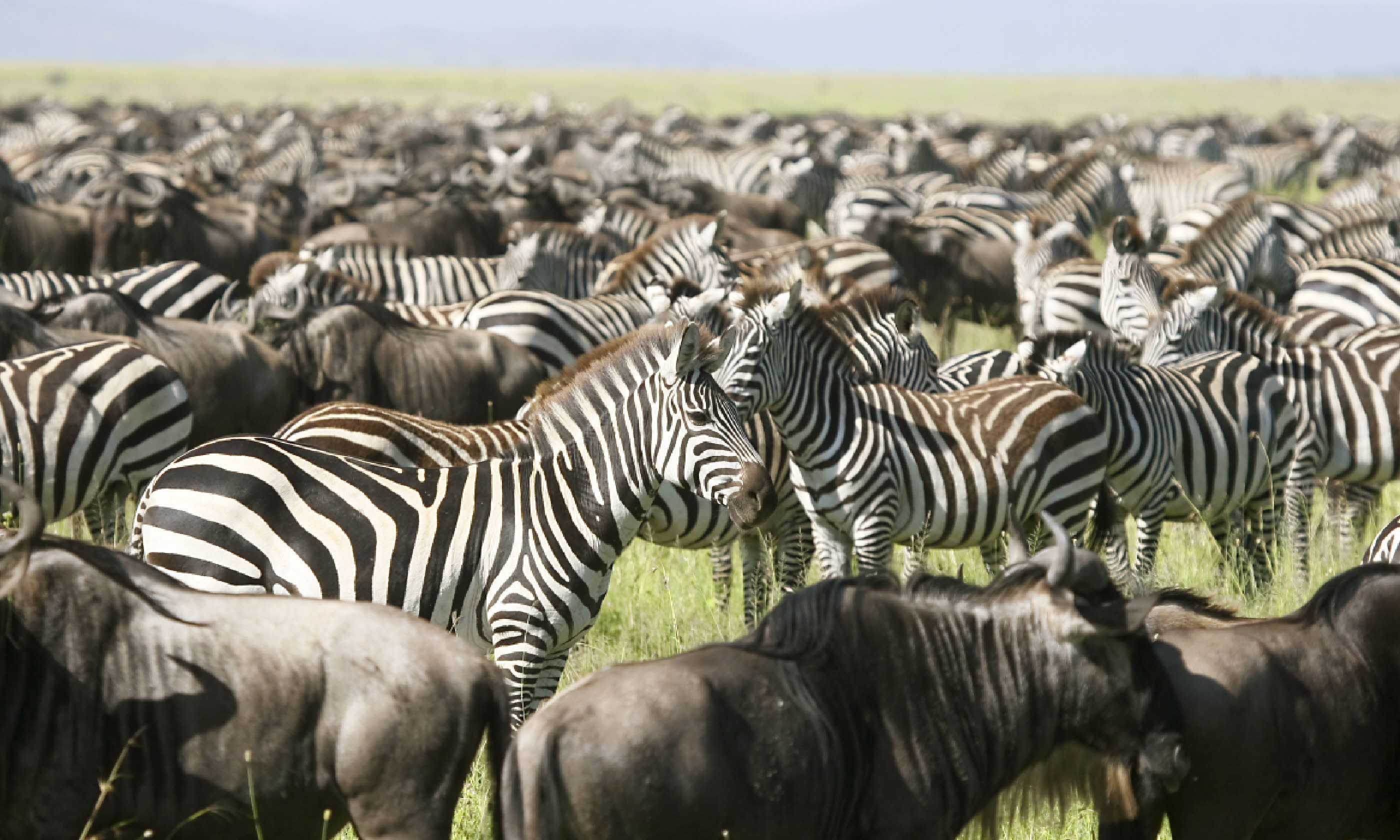
Not many people realise that the Great Migration is a year-round spectacle – not just a one-time annual occurrence. Here's how to time your trip for the best wildlife viewing...
There are five main stages to the migration: The calving season in the short-grass plains of the southern Serengeti (late-Jan to mid-March); the trek north across the central and western Serengeti during the long rains in April and May; the crossings of the Grumeti and Mara rivers; the arrival of the herds in the Masai Mara (usually by early August); and, finally, the journey south back into the Serengeti at the onset of November’s short rains.
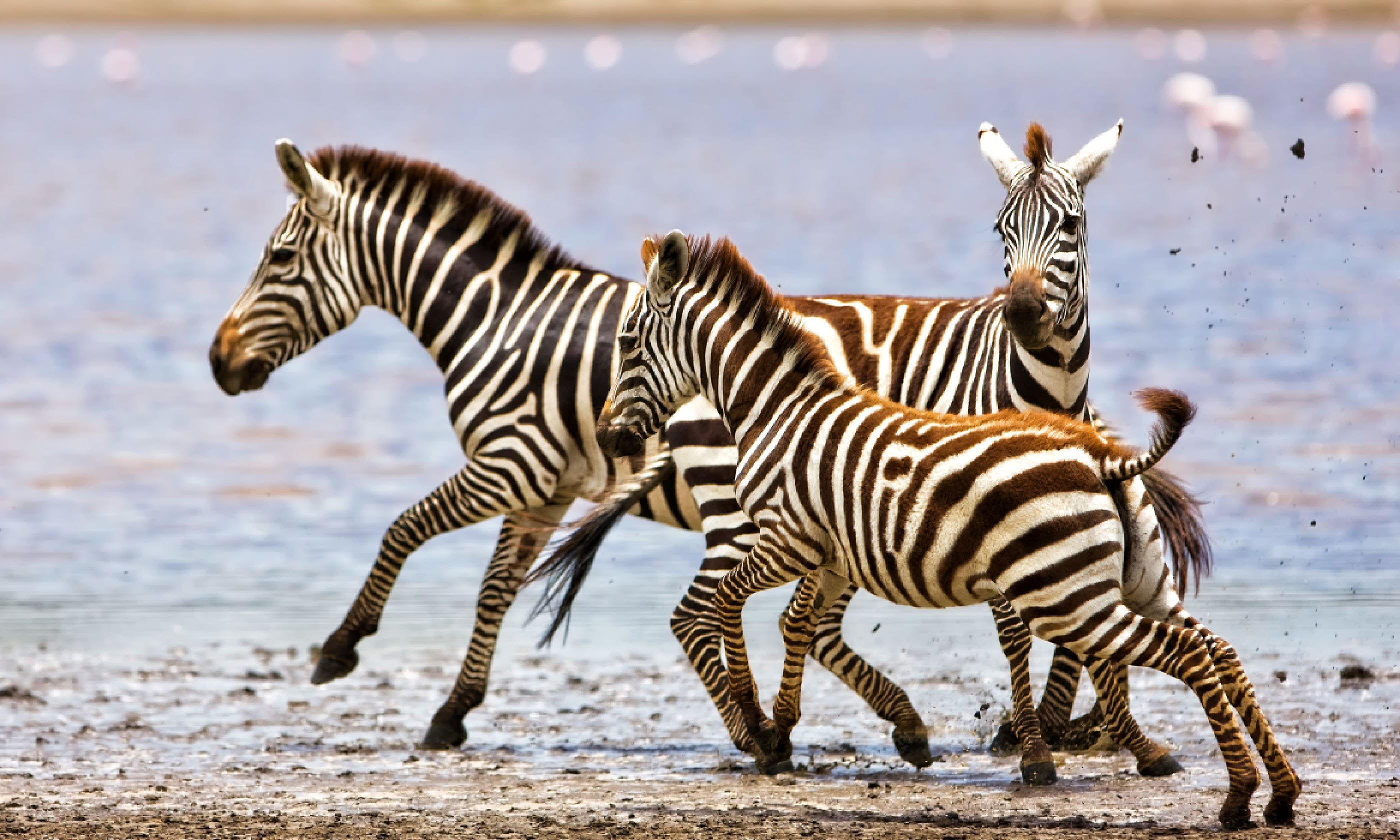
Zebras running beside Lake Ndutu in the Serengeti National Park (Shutterstock)
What’s happening: The Migration has settled in the short-grass plains of the southern Serengeti, near Lake Ndutu. The short rains usually fall here in November and December, luring herds in search of fresh pasture from the central Serengeti.
Nourished by phosphorous-rich soils, the grasslands of the Southern Plains offer particularly nutritious grazing. Wildebeest, zebra and gazelle begin to calve towards the end of the month, pricking the ears of predators. There are numerous lion prides in the marsh and woodland areas near Lake Ndutu, while the wide-open plains are perfect hunting grounds for cheetah.
Where to be: Seasonal camps, including Olakira Camp, Serengeti Safari Camp and Serengeti Under Canvas. Permanent accommodation includes Ndutu Safari Lodge and Ngorongoro Conservation Area. Also within range of the herds, Sanctuary Kusini is built on a kopje deep in the Serengeti.
What’s happening: Calving continues, with up to 500,000 wildebeest being born on the Southern Plains during a two- to three-week window. The gangly, fawn-coloured offspring are soon running with the herd.
Far from being static, the wildebeest move around the plains as local rain showers rejuvenate areas of grassland. If the Southern Plains become particularly denuded, the herds may wander as far west as Maswa Game Reserve, or east and south into the Ngorongoro Conservation Area.
Where to be: You should be in easy driving distance of the herds from the Ndutu and Kusini areas (see January). Due to its central position in the Serengeti, the small settlement of Seronera can be used as a base for viewing the migration from about November to June (but be prepared for some long, bumpy drives to find the herds). It’s a popular spot with abundant resident game, but it can get very busy. The Seronera Wildlife Lodge is a good bet for the budget conscious.
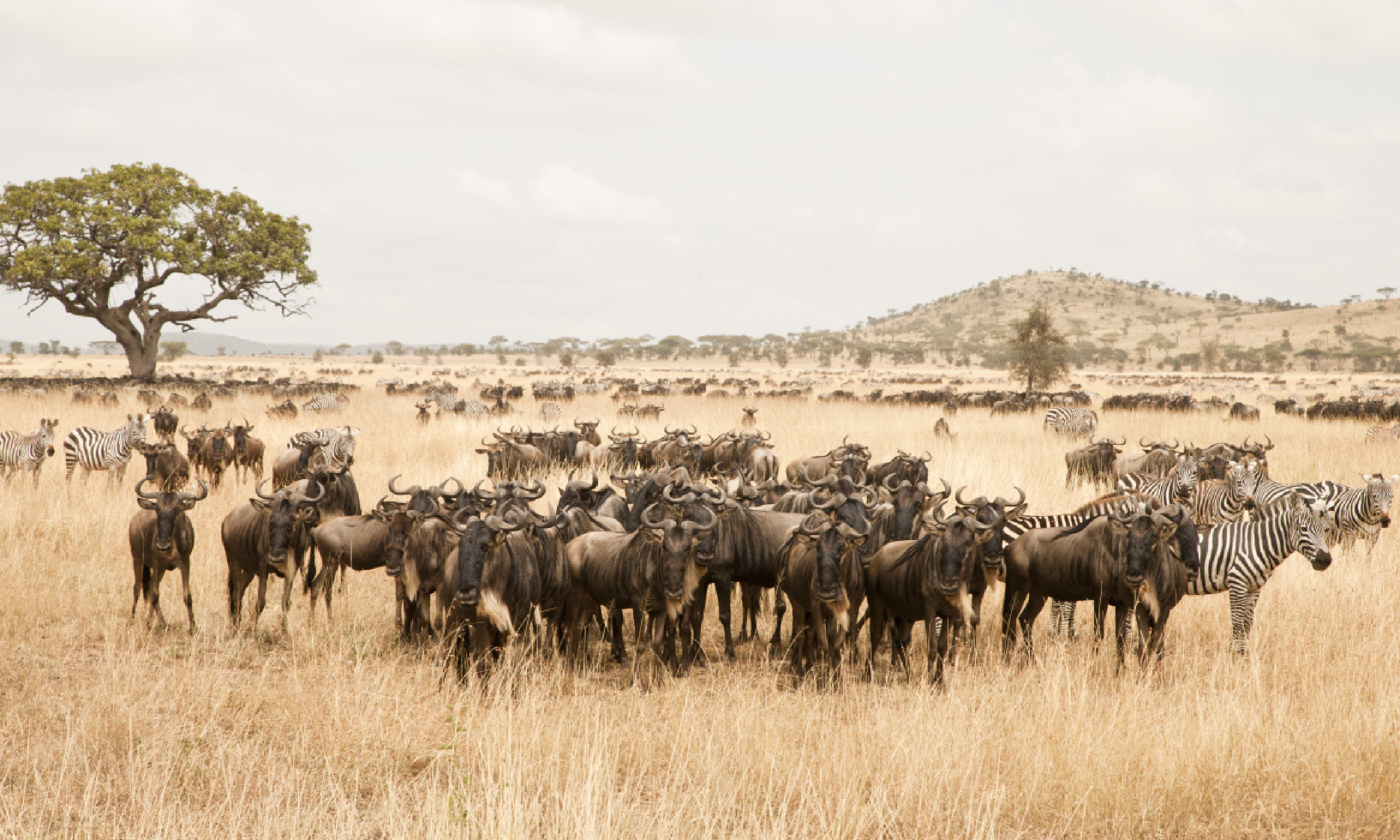
Seronera, Serengeti National Park, Tanzania
What’s happening: The Southern Plains are beginning to show the strain. Several weeks of intensive grazing have taken their toll, but the wildebeest, zebra and Thomson’s gazelle continue to give birth until mid-March.
There are rumblings of thunderstorms to the north and west, however, and soon the herds will be following their noses in search of rain and fresh grass.
Where to be: The Ndutu region still gives you the best chance for being in close touch with the Migration at this time of year. However, to avoid disappointment consider combining a southern Serengeti safari with the nearby Ngorongoro Crater where wildlife is abundant year-round.
What’s happening: The Southern Plains are finally exhausted and the Migration moves towards the Western Corridor of the Serengeti as the long or heavy rains set in. It’s a slow plod through scattered woodland and long-grass plains, the herds streaming past the Moru Kopjes and shadowing the Mbalageti River.
Where to be: Tucked into the Moru Kopjes, Dunia Camp has a lion’s eye view of the plains while the Serengeti Serena Safari Lodge has an equally panoramic outlook. Both properties are well placed to intercept the Migration as it trundles westwards, but be warned that heavy rains at this time of year can reduce tracks to quagmires and make game drives a challenge.
On the plus side, there are few other visitors. Also consider the Serengeti Sopa Lodge and Seronera Wildlife Lodge – both are located near permanent water with excellent resident game.
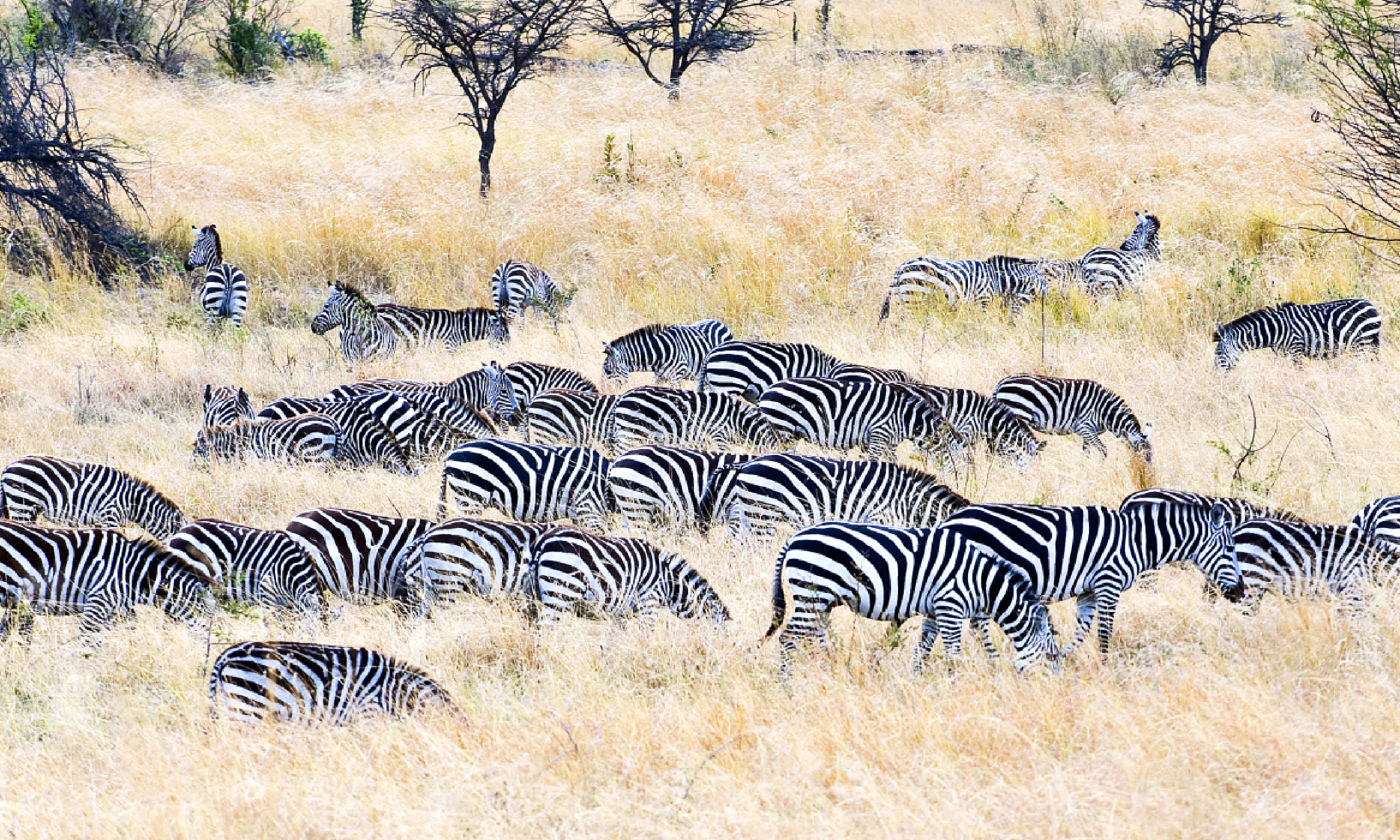
Serengeti National Park, Seronera area (Shutterstock)
What’s happening: As the long rains begin to dwindle, columns of wildebeest continue to enter the Western Corridor of the Serengeti. Others head north of the Seronera region, but the bulk of the migrating herds enter the Ndoha and Dutwa Plains that flank the Mbalageti River. Towards the end of the month, there is a sense of expectation as the Migration piles into the narrow wedge of land between the forest-lined river courses of the Mbalageti and Grumeti.
Driving conditions can still be affected by rain at this time of year, but determined travellers will be rewarded with low-season rates at camps, plus the added bonuses of the grasslands in flower and the start of the wildebeest rut. However, in years when the rains persist throughout May, the wildebeest may be scattered over a wide area of the central Serengeti.
Where to be: Properties in the Seronera region are still a good option, while Mbalageti Camp is perfectly placed near the entrance to the Western Corridor. As the month progresses, everyone wants to be based along the Grumeti River.
What’s happening: By June the rains have stopped and the wildebeest rut is well underway. The grasslands reverberate to the bellows and grunts of testosterone-fuelled males as they chase rivals and round-up females – the latter adding to the din as they try to maintain contact with their calves.
Munching its way through the Western Corridor, the Migration begins to coalesce into a ‘mega herd’, bunched up along the southern bank of the Grumeti River.
The smaller herds that branched north before reaching the Western Corridor continue their trek towards the Ikorongo Game Controlled Area.
All eyes, however, are on the main contingent of the Migration – amassing for the Grumeti River crossings. These can start early in the month, herds splashing through what is usually a series of pools and channels rather than a continuous, flowing river. As the frequency of crossings intensifies during June, the Grumeti’s large crocodiles enjoy their annual glut of wildebeest and zebra flesh.
Where to be: Prime spots for viewing Grumeti River crossings include Grumeti Serengeti Tented Camp and Kirawira Camp, both located in the Serengeti National Park. Faru Faru River Lodge, Sabora Tented Camp and Sasakwa Lodge are three stylish Singita properties in a huge private concession to the north of the river.
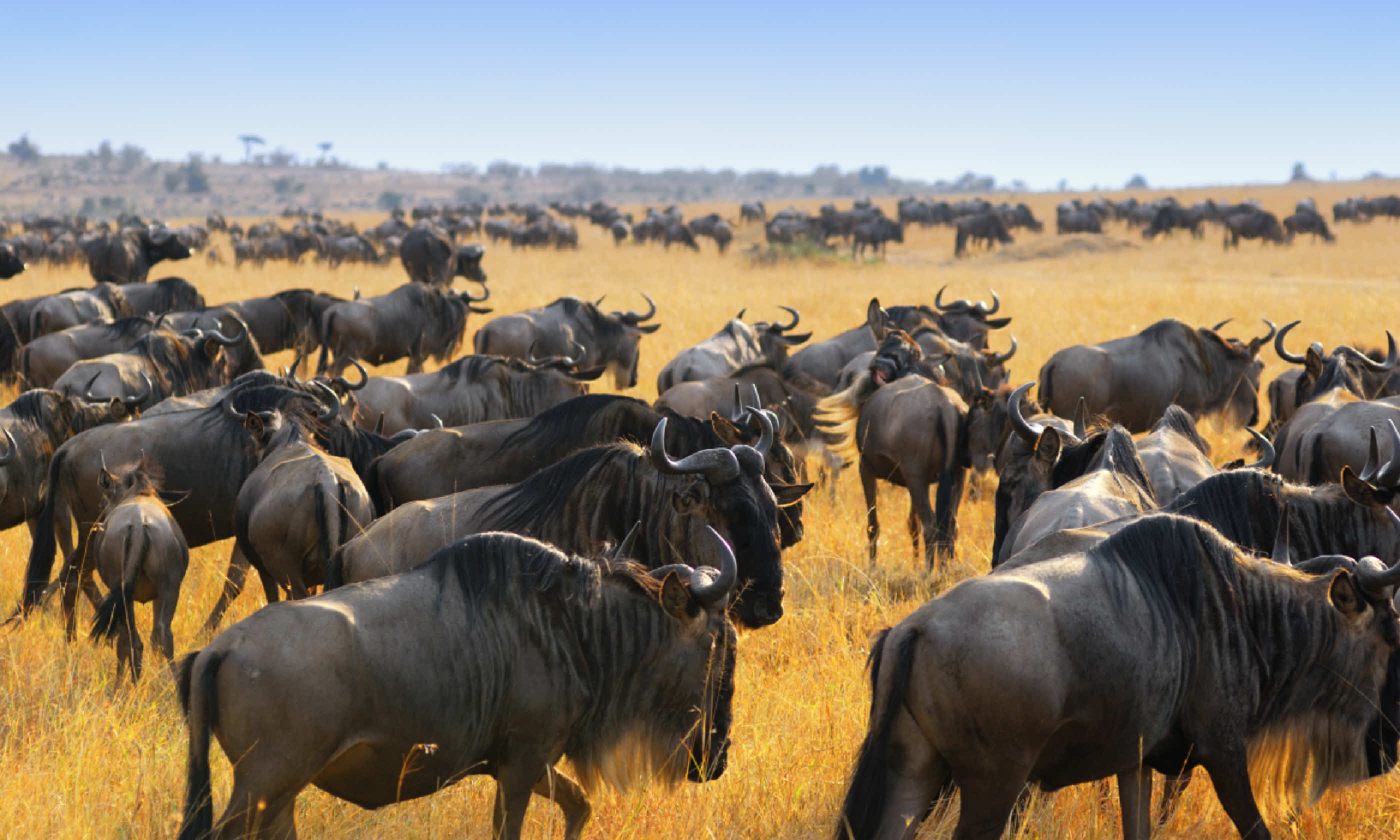
Masai Mara, Kenya
What’s happening: With the Grumeti River in their wake, the wildebeest, zebra and gazelle push northwards, the sweet scent of the Mara grasslands in their nostrils.
Herds spread out on a broad front that extends from the Grumeti Game Reserve and Ikorongo Game Controlled Area to the northern reaches of the Serengeti. Large herds can be found as far east as Lobo.
When the Migration actually crosses into Kenya’s Masai Mara depends, as ever, on rainfall patterns and how long the northern Serengeti grasslands can sustain the herds. In some years it happens as early as mid-June; in others, it’s well into August and September.
It’s a common misconception that the crossing of the Mara River marks the transition of the Migration from Tanzania to Kenya. The river actually meanders through the north-west Serengeti before looping north into the western reaches of the Masai Mara, throwing repeated water obstacles in the path of the herds. That means you can stake out likely crossing points on either side throughout July and August.
Where to be: The Lamai Wedge is a stunning tract of land in the northern Serengeti, between the Mara River and the Kenyan border, and is easily accessed by Sayari Camp and the Lamai Serengeti. Serengeti Bushtops is also located close to the Mara River, while seasonal camps in the area include Lemala Mara, Olakira and Serengeti Under Canvas. If you’re anticipating the arrival of the Migration into the Masai Mara, there’s a huge range of accommodation at temptingly pre-peak prices (see Aug/Sept).
What’s happening: The northward thrust continues. In a typical year, you can expect the Migration to have reached the Masai Mara by early August. River crossings often reach their frenzied climax this month as large herds take a leap of faith into the Mara River – much to the delight of the waiting crocs and lions. Don’t be surprised to find 50 or more safari vehicles parked at popular river-crossing points in the Masai Mara. It’s the summer holidays and the reserve is at its busiest.
The riverbanks become thick with vultures and marabou storks feeding on the corpses of drowned wildebeest clogging up the river. Elsewhere in the Mara you’ll see less macabre scenes of wildebeest and zebra filing through long, golden grasslands.
Where to be: Kenya’s finest wildlife sanctuary has plenty of superb camps and lodges, both in the national reserve itself and in neighbouring conservancies. Mara Serena Lodge, Mara Intrepids, Rekero Camp and the Governors’ Camps are located in the western half of the Masai Mara National Reserve, within easy reach of river crossing points.
All camps and lodges in the wider Mara area can organise full-day excursions into the national reserve, enabling you to witness the Migration and then retreat to the more intimate, less trammelled realm of a conservancy (often with added benefits such as walking safaris, which aren’t permitted in the National Reserve).
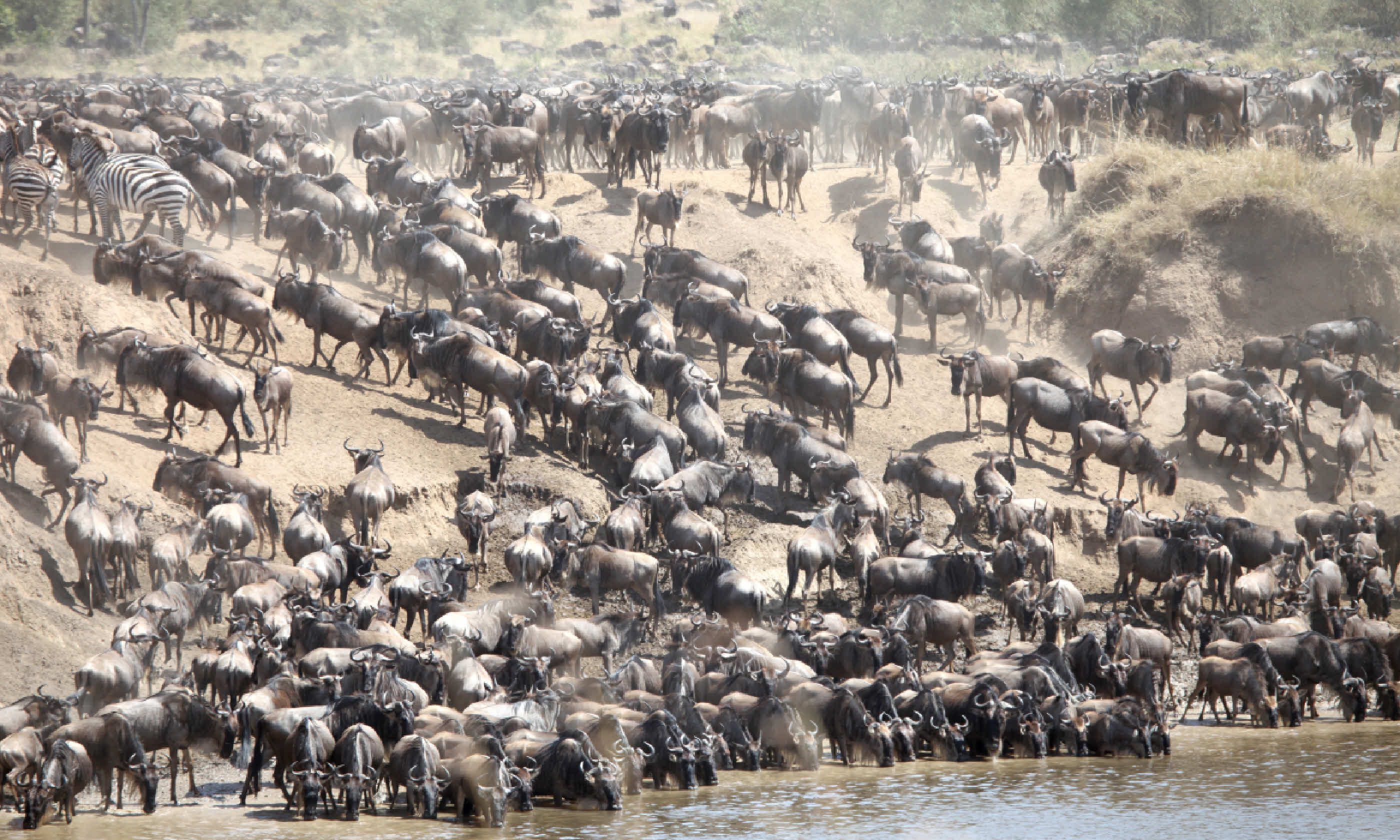
Wildebeest in the Masai Mara (Shutterstock)
What’s happening: Herds may still be scattered across the northern Serengeti, either about to cross into the Masai Mara or content to remain in Tanzania, grazing the rolling plains. The focus of the Migration, however, is firmly in Kenya where the wildebeest edge slowly eastwards through the Masai Mara.
They’ll wander wherever there is fresh green grass, so you can also expect to encounter large herds in the conservancies surrounding the reserve. River crossings continue throughout the month, while abundant lion, cheetah and hyena are never short of prey.Where to be: It’s a great time to be in the Mara – the summer holiday crowds begin to thin, but the Migration is still thick on the ground. Choice picks for (top end) places to stay include &Beyond’s Kichwa Tembo and Bateleur Camps, Basecamp Masai Mara, Fig Tree Camp, the Governors’ Camps, Kicheche Mara and Bush Camps, Mara Plains Camp, Mara Bushtops, Mara Porini and Porini Lion Camps. Budget options are limited to campsites near the Oloolaimutiek and Talek gates.
What’s happening: After the general ‘mingling in the Mara’, the herds begin to move with renewed purpose.
Any week now, rains may start falling on the short-grass plains of the southern Serengeti and the wildebeest need to be there when fresh green shoots have pushed to the surface. And so begins the long trek south, the Migration gradually spilling from the Masai Mara back into the north-east Serengeti and Loliondo Game Controlled Area.
Where to be: Perched below the Kuka Hills in a private concession in Loliondo, &Beyond’s Klein’s Camp often has a grandstand view of the Migration, while Nomad’s Serengeti Safari Camp and Nduara Loliondo Camp are also well placed at this time of year. Further south, Lobo Wildlife Lodge and Migration Camp both have lofty positions on kopjes.
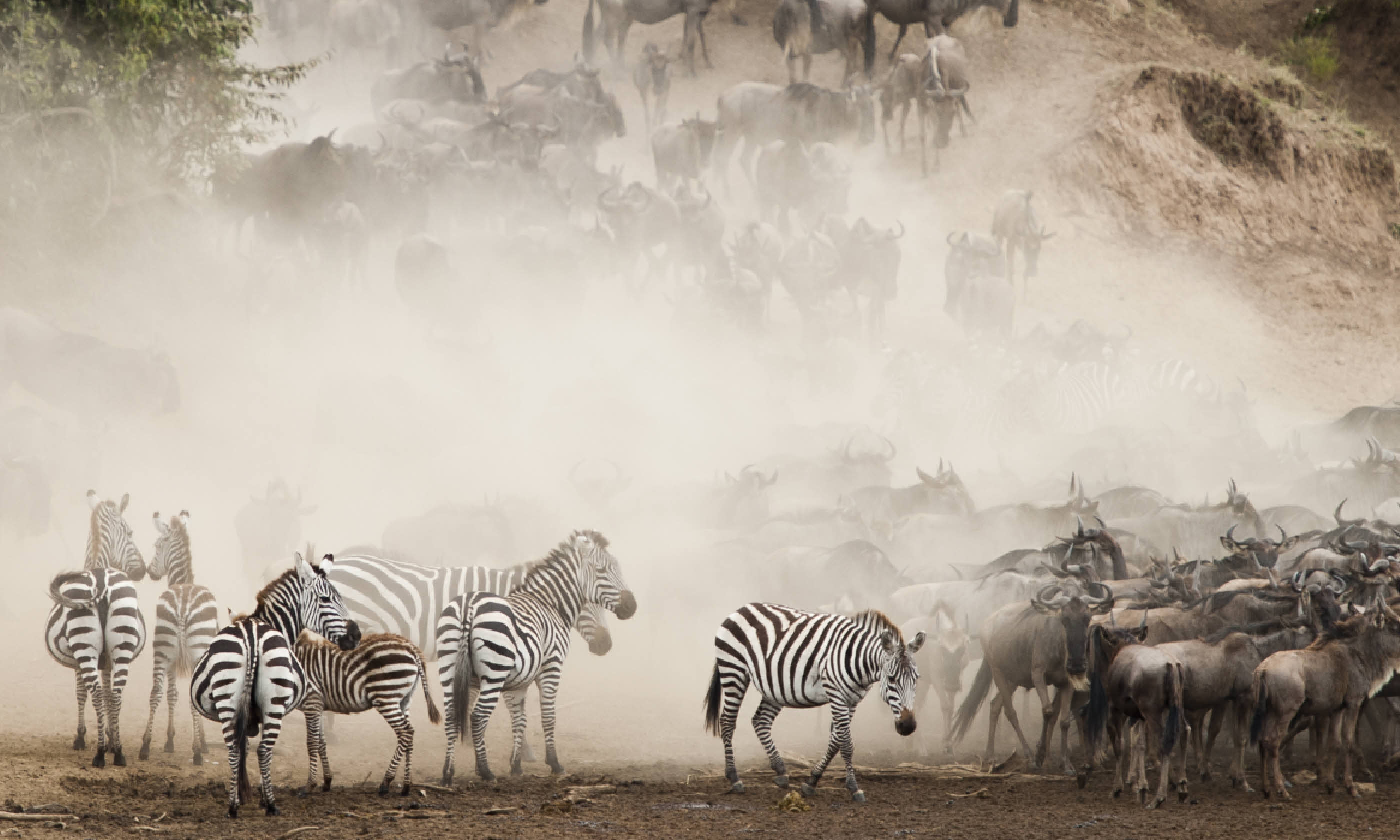
What’s happening: The herds pick up the pace as the short rains lure them southwards. By now most, if not all, of the wildebeest and zebra will have left the Mara. They form long columns stretching from Lobo to the central Seronera area of the Serengeti.
Where to be: Lobo Wildlife Lodge can still be a good option but, as the month progresses, look more to the south. Serena’s Mbuzi Mawe Tented Camp and Four Seasons Serengeti Safari Lodge are close to the main Migration corridor, as are properties in the Seronera area (see February-April).
What’s happening: The herds reach the southern Serengeti where fresh grass covers the short-grass plains.
Where to be: Lodges and seasonal camps in the Seronera and Ndutu areas (see January-March) once more become the focus of Migration viewing.
Check out our Great Migration, Serengeti, Tanzania travel guide for more articles, tips and trip ideas... More
Top 15 tips for taking Great Migration photos | Inspire me... More
The Great Migration, Tanzania | Destinations... More
Sssh! Don't tell anyone: Africa's secret migration in Zambia | Destinations... More
The ultimate African safari | Destinations... More